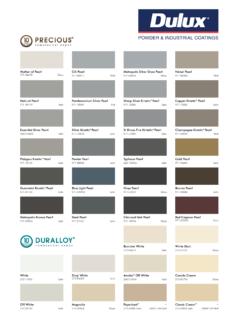Transcription of Colour in Learning: It’s Effect on the Retention Rate of ... - ed
1 Journal of Education and Practice ISSN 2222-1735 (Paper) ISSN 2222-288X (Online) , , 2015 1 Colour in Learning: It s Effect on the Retention Rate of Graduate Students Dr. Oluwakemi Olurinola * Dr. Omoniyi Tayo Department of Science and Technology Education, Olabisi Onabanjo University, Ago-Iwoye, Nigeria * E-mail of the corresponding author: Abstract Cognitive psychologists have discovered different design principles to enhance memory performance.
2 It has been said that retrieving process depends on many variables and one of them is Colour . This paper provides an overview of research on Colour and learning. It includes the Effect of Colour on attention, Retention and memory performance, and relates these to the design of instructional materials. The study reported the Effect Colour had on the Retention rate of graduate students of the Olabisi Onabanjo University, Ago-Iwoye. Thirty graduate students participated in this study. The purpose of this research study was to determine if Colour (in prints form) influence the learning process.
3 The independent variable was Colour at two levels: Congruent colours (colours corresponding to the words) and Incongruent colours (colours not related to the words), while for the control, Achromatic colours (black and shades of grey) were used. The dependent variable was the Retention rate number of words recalled. The research design was a posttest only design. A one-way ANOVA was used to analyze the data and the results indicated that there was a statistically significant difference in the number of words recalled based on Colour .
4 The groups exposed to congruent colours and achromatic colours performed better than those exposed to incongruent colours, although the group exposed to the congruent Colour prints performed better than those of the other groups. Therefore designers of instructional materials need to use Colour wisely by paying attention to the Effect of Colour on learning. Keywords: Colour , Learning, Retention , Instructional Design 1. Introduction Memory refers to the mental process of encoding, retaining, and retrieving information (Dzulkifli & Mustafar, 2013).
5 How the human cognitive system deals with the memorization process remains the centre of research among cognitive psychologists. One of the most interesting and challenging questions in contemporary memory research is on ways to enhance human memory performance. Many variables have been advanced as contributing to the retrieval operations and such include Colour (NIA, 2008; Pett &Wilson 1996). Colour is believed to be the most important visual experience of human beings (Dzulkifli & Mustafar, 2013). It functions as a powerful information channel to the human cognitive system and has been found to play a significant role in enhancing memory performance.
6 Therefore, in searching for strategies to facilitate the learning process, colours must be recognized as capable of motivating students to learn and profit from their educational experiences. (Wichmann, Sharpe, & Gegenfurtner, 2002). Colour is used almost universally in the production of instructional materials, such as slides, filmstrips, motion pictures, video programmes. Printed instructional materials and computer assisted instruction are almost always produced in Colour . Whether it is on a computer screen, in print form or even paint on a classroom wall, Colour affects students' ability to learn However, Nazzaro, (2008) notes that this attribute is often used without due consideration for what is known about it from research and practice (Nazzaro, 2008).
7 Choosing an appropriate Colour for any PowerPoint presentation or any tutorial is as an impetus for learning. Colours can be described in temperature terms: colours in the red range of the spectrum are subjectively known as warm colours (active, stimulating); colours in the blue range of the spectrum are considered cool colors (restful, quiet) Colour harmonies describe the relationship certain colours have with one another on the Colour wheel, and how they can be selected to create a pleasing Colour selection, while discordant colours are colours not in their natural order, not pleasing or balanced.
8 Monochromatic Colour schemes use a single hue with variation in saturation and brightness. Achromatic colours are black, white, and shades of gray. Congruent colours are those closely related to the words, in which the ink Colour and the word refer to the same Colour green used for grass or pink in used for the word pink . Incongruent colours: colours that are not closely related to the word, the Colour and words are different purple used for grass, or orange ink used the word pink . Colour is a powerful tool, which has many uses in education. It can be used to get attention, enhance clarity, establish a code, label things in nature and differentiate items.
9 Teachers also use various colours to influence learning outcomes. For example in schools we are asked to stick to blue or black ink. The red ink is supposed to be used by teachers to correct assignments, notebooks, and class works. It is definitely done to draw our attention to the mistake we make. In one way, red is threatening but in another way it makes us feel anxious and enhances our learning outcomes, in the sense that we will remember not to repeat the points highlighted in Journal of Education and Practice ISSN 2222-1735 (Paper) ISSN 2222-288X (Online) , , 2015 2 red.
10 Also while showing the differences between two or three concepts teachers generally make use of coloured chalks so as to make the differences prominent. Furthermore, in the classroom, writing board is often black in Colour so that white Colour will be easily visible and now with the advent of white boards more colours can be used on the board. Another example can be the use of a highlighter to mark an important piece of information in a text book. So colours used in the right proportion can enhance learning and benefit us in a number of ways whereas it will have exactly the opposite if not properly used.















